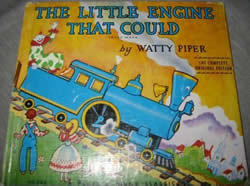
Remember the train that said “I think I can, I think I can”? Do you remember the moral of The Little Engine That Could? Readers typically latch on to the theme about perseverance — if you keep trying, you will succeed.
But there is a “more moral” moral to the story. Remember why the little engine was trying to get over the mountain? It was to take toys to the children in the town on the other side in time for Christmas, so the children would be not be sad on Christmas day. So the more pro-social, less self-centered message of the story is: When people need help, work as hard as you can to help them and don’t give up.
Some contend that children should hear moral stories so they develop moral literacy and, consequently, moral character. In other words, let the stories do their magic without adult assistance. Our research shows that leaving a story and a child on his or her own does not guarantee that an intended message will be understood. In our studies, 8-year-old children rarely (10 percent of the time) picked up the author’s intended message; 10-11 year olds understood the intended message about half the time.
So what can a parent do to facilitate comprehension of a story and its moral? First, understand that children do not have the life experience to interpret the significance of many story events. So be patient. Imagine yourself in another country trying to learn the social norms. You focus on the little things, not the big picture. This is what children spend much of their time doing—figuring out what is going on in the story, so much so that it is hard to step back and see the big picture and get the moral.
Even if a child is made aware of the big picture, the mind may be overwhelmed with too much detail to take it in. The moral of the story may just be too hard to remember among the flood of loose detail in the child’s mind.
Second, understand that telling someone the theme of the story does not mean the lisener will agree with you. Whether adult or child, story readers construct their own messages (based on unique life experiences). Just try letting someone else completely change your reaction to an American Idol contestant. It is very hard to change your gut reaction.
As you may have noticed, even adults get different messages from a story. How do we heighten our own awareness of the morals in stories, not to speak of our children’s awareness?
My students and I suggest questions for discussion during or after reading (or watching) a story. These can increase awareness of story elements and how they fit with one’s own moral life.
For example:
Moral sensitivity: What is the character feeling? Is the character sensitive to the needs of others?
Personal application: When recently have you been sensitive or insensitive to another person’s feelings?
Moral judgment: Does the character make good decisions or choices for self and the community? What makes it a good or bad choice?
Personal application: Does it remind you of a time in your life when you made a good or bad choice? How did the choice affect others?
Moral focus: Did the character try to be the best person he or she could be? Did the character show concern for the welfare of others?
Personal application: Did you do this today when…?
Moral action: Did the character take positive moral action? Did the character change tactics when things were not working? Did the character persevere even when things were hard? How did the action affect the character and others in the story?
Personal application: How have your actions affected others today?
If you are the parent of a young child, I invite you to go back and read The Little Engine that Could. But this time, with those questions above in mind, see what message you take away now. With age, adults become more aware of and concerned about social and moral consequences. We can only hope our children do, too. In the meantime, by talking with our children about the deeper moral we see in the story, we can help them see as well.
Other resources:
A guidebook on discussing morals in stories for parents and teachers, Tuning into Ethical Behavior.
Collaborative for Ethical Education
An October 10-12, 2010 Notre Dame Symposium on Human Nature and Early Experience.
Darcia Narvaez’s blog, at Psychology Today, Moral Landscapes.
You can link to published books and download papers and tools for parents on Darcia Narvaez’s website
Darcia Narvaez is an associate professor of psychology at Notre Dame specializing in moral development and character education in children. She is the director of Notre Dame’s Collaborative for Ethical Education and the author or co-author of numerous publications on character development.